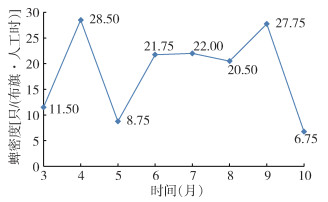扩展功能
文章信息
- 张乾通, 孙继民, 凌锋, 施旭光, 任江萍, 郭颂, 张蓉, 刘营
- ZHANG Qian-tong, SUN Ji-min, LING Feng, SHI Xu-guang, REN Jiang-ping, GUO Song, ZHANG Rong, LIU Ying
- 浙江省2021年发热伴血小板减少综合征报告病例及蜱媒监测结果分析
- Analysis of reported cases of fever with thrombocytopenia syndrome and tick vectors surveillance results in Zhejiang province of China in 2021
- 中国媒介生物学及控制杂志, 2022, 33(4): 485-488
- Chin J Vector Biol & Control, 2022, 33(4): 485-488
- 10.11853/j.issn.1003.8280.2022.04.008
-
文章历史
- 收稿日期: 2022-02-14
2 浙江省疾病预防控制中心传染病预防控制所, 浙江 杭州 310051
2 Department of Infectious Disease Control and Prevention, Zhejiang Provincial Center for Disease Control and Prevention, Hangzhou, Zhejiang 310051, China
发热伴血小板减少综合征(severe fever with thrombocytopenia syndrome,SFTS)是一种由发热伴血小板减少综合征病毒(Severe fever with thrombocytopenia syndrome virus,SFTSV)感染引起,以发热伴血小板和白细胞减少为主要临床表现的新发蜱媒传染病[1-2]。2009年在中国大陆首次被发现以来,其发病范围逐步扩大。近年来,SFTS报告病例逐年上升,且病死率维持较高水平,严重威胁人民群众生命安全,成为重要的公共卫生问题[3-5]。本文旨在分析浙江省2021年通过疫情网络报告的SFTS病例的流行特征及蜱媒监测现状,为进一步开展SFTS防控工作提供基础数据。
1 材料与方法 1.1 资料来源从中国疾病预防控制信息系统传染病报告信息管理系统中获取2021年浙江省SFTS病例资料,包括所有疑似病例和实验室确诊病例,依据“现住地址”和“发病日期”对病例进行统计整理。人口数据来自于中国疾病预防控制信息系统的基本信息系统。
1.2 诊断标准根据流行病学史、临床表现和实验室检测结果进行病例诊断,诊断标准参照原国家卫生部印发的《发热伴血小板减少综合征防治指南(2010版)》[6]。
1.3 媒介蜱监测方法游离蜱采用布旗法,用90 cm×60 cm的白色布旗,窄的一边两端用杆子固定,在监测生境中均匀地拖或挥旗,每步行10 m停下检视附着的蜱,将附着在布旗上和拖蜱者身上的蜱用镊子捡起装入管内,一般每一样地拖(挥)旗不能少于500 m,时间不能少于30 min,记录捕获蜱的数量,计算游离蜱密度。寄生蜱采用动物体表检蜱法,肉眼观察或用手触摸蜱,采集宿主体表上的所有蜱[7]。

|
应用描述流行病学方法对浙江省2021年SFTS的流行特征进行分析。采用Excel 2013软件进行病例和媒介蜱监测数据整理、清洗,并建立数据库。使用ArcGIS 10.0软件绘制以区(县)为单位的SFTS发病率地图。应用SPSS 17.0软件进行统计学分析,不同特征发病人群率的比较采用χ2检验,以P < 0.05为差异有统计学意义。
2 结果 2.1 发病概况2021年全省共计报告SFTS病例85例,均为确诊病例,报告发病率为0.15/10万。报告SFTS死亡病例7例,病死率为8.24%(7/85)。
2.2 病例地区分布2021年浙江省除温州、嘉兴和衢州市外,全省11个地市中共计8个地市有SFTS病例报告,主要分布在金华(27例)、台州(27例)和宁波市(11例),占总报告病例数的76.47%(65/85)。病例分布在23个县(市、区),除桐庐、德清和缙云县为新增报告病例县外,其余20个县(市、区)既往均有病例报告。报告发病率居前3位的县(市)为天台县(3.94/10万)、岱山县(1.86/10万)和兰溪市(1.41/10万)。见图 1。

|
| 图 1 2021年浙江省发热伴血小板减少综合征病例报告地区分布 Figure 1 Spatial distribution of severe fever with thrombocytopenia syndrome (SFTS) cases in Zhejiang province in 2021 |
| |
除1月和12月外,其余月份均有SFTS病例报告,主要分布在4-10月,占总报告病例数的91.76%(78/85)。5-7月为发病高峰期,占总报告病例数的62.35%(53/85);11月至次年2月为相对静息期,发病数较少。见图 2。

|
| 图 2 2021年浙江省发热伴血小板减少综合征病例发病时间分布 Figure 2 Temporal distribution of severe fever with thrombocytopenia syndrome (SFTS) cases in Zhejiang province in 2021 |
| |
报告病例以中老年为主,其中年龄最大者93岁,最小者25岁,中位年龄67岁,50岁及以上年龄组占94.12%(80/85)。报告死亡病例共7例,其中75岁及以上年龄组6例。男性病例49例,女性病例36例,男女性别比为1.36∶1,报告发病率分别为0.16/10万、0.13/10万,男性和女性报告发病率差异无统计学意义(χ2=1.347,P=0.246)。报告病例职业以农民为主,占80.00%(68/85),其次为家务及待业,占11.76%(10/85)。发病前2周有明确蜱叮咬史、叮咬史不详和无叮咬史的病例分别占17.65%(15/85)、47.06%(40/85)和32.29%(30/85)。
2.5 媒介监测结果2021年3-10月全省8个县(市、区)的农村外环境和农村居民区同时开展游离蜱和寄生蜱监测,共计捕获游离蜱590只,平均蜱密度为18.44只/(布旗∙人工时),其中4和9月密度较高,分别为28.50和27.75只/(布旗·人工时)(图 3)。共计监测动物688只(头),捕获寄生蜱2 406只,平均寄生蜱密度为3.50只/宿主,其中羊(山羊)、牛和犬寄生蜱密度分别为3.05只/宿主(1 450/475)、8.04只/宿主(539/67)和2.67只/宿主(417/156)。

|
| 图 3 2021年浙江省发热伴血小板减少综合征监测点游离蜱密度月变化 Figure 3 Monthly change of free tick density at severe fever with thrombocytopenia syndrome (SFTS) surveillance sites in Zhejiang province in 2021 |
| |
我国自2010年开始SFTS监测,并参照乙类法定报告传染病进行报告和管理。目前全国已有25个省份有SFTS病例报告[3],主要集中在河南、山东、湖北、安徽、浙江、辽宁和江苏省[8-9]。本文对2021年浙江省SFTS监测数据进行系统分析,结果显示:全省共计8个市23个县(市、区)报告SFTS确诊病例85例,死亡7例,病死率(8.24%)低于2015-2019年浙江省SFTS平均病死率(10.39%)[10],高于2010-2017年全国平均病死率(6.34%)[8]。2021年浙江省SFTS病例在地区分布上总体呈现3个特点:一是病例呈高度散发状态,分布范围广泛;二是病例分布具有明显的地域性,大部分病例分布在浙江省中东部山地丘陵的农村地区,浙西、浙南地区报告病例数较少;三是有3个县首次报告病例,疫区范围有逐渐扩大趋势。
监测结果显示,SFTS发病具有一定的季节性,但主要分布在4-10月,5-7月达到发病高峰期;发病人群以50岁以上中老年农民为主,与黄晓霞等[9]报告的2018年全国SFTS流行特征相似,也与浙江省既往年份监测结果相似[10]。SFTS作为一种蜱传疾病,其发病时间与蜱的活跃期以及人群野外劳作(暴露)密切相关[9]。从传播媒介来看,蜱在浙江省各地区均有分布,本研究监测结果显示在SFTS的流行期(4-10月)自然环境游离蜱和寄生蜱密度均较高。从发病人群来看,中老年农民作为浙江省山区农村的主要劳动力,加之饲养家畜,增加了蜱暴露的概率和感染风险,提示在蜱活跃期,丘陵、山区、森林等地区从事生产生活或赴这些地区旅游、户外活动的人群要做好个人防护,避免蜱叮咬[9, 11-12]。监测结果显示病例发病前14 d内有明确蜱叮咬史的仅占17.65%,大部分病例叮咬史不详或无蜱叮咬,一方面可能为蜱叮咬时其唾液腺分泌的抗凝物质和局部麻醉剂使受害者不易察觉,致使对蜱叮咬情况进行调查时,部分调查对象提供“叮咬情况不详”或“否认蜱叮咬”的答案;另一方面该病是否存在除蜱叮咬传播和有限的人传人外的其他传播机制也有待进一步研究[7, 13]。
本文也存在一定的局限性,一是在结果解读时,需要注意本研究中SFTS监测数据来自于被动监测系统,鉴于发热、乏力、白细胞和血小板下降等SFTS症状或特征是非特异的,存在病例漏报的可能,浙江省部分地市也在尝试探索开展相关症状监测,力争早发现、早诊断,减少漏诊、误诊;二是本研究未对采集的蜱开展进一步的SFTSV带病毒情况调查。SFTS作为一种新发的蜱媒传染病,病死率高,浙江省SFTS疫区范围可能会进一步扩大,因此,应采取一些针对性防控措施:一是在该病的流行季节,加强对重点地区高发人群的健康教育,提升人群防病和就诊意识;二是强化医务人员蜱传疾病诊治培训,提高鉴别能力和诊治水平,早发现、早诊断、早治疗,减少漏诊、误诊和重症死亡病例的发生;三是要在当地政府领导下,多部门协作,探索利用环境改造、化学与生物防制等综合干预手段降低蜱媒密度,进一步总结推广蜱媒传染病防制经验;四是进一步加强疾病监测,开展蜱传病原体相关研究。
志谢 感谢浙江省平阳、安吉、浦江、定海、岱山、椒江、临海和景宁等县(市、区)SFTS监测点同仁对监测工作的支持。利益冲突 无
| [1] |
Yu XJ, Liang MF, Zhang SY, et al. Fever with thrombocytopenia associated with a novel bunyavirus in China[J]. N Engl J Med, 2011, 364(16): 1523-1532. DOI:10.1056/NEJMoa1010095 |
| [2] |
Casel MA, Park SJ, Choi YK. Severe fever with thrombocytopenia syndrome virus: Emerging novel phlebovirus and their control strategy[J]. Exp Mol Med, 2021, 53(5): 713-722. DOI:10.1038/s12276-021-00610-1 |
| [3] |
李佳宸, 王玉娜, 赵静, 等. 发热伴血小板减少综合征流行病学研究进展[J]. 中华流行病学杂志, 2021, 42(12): 2226-2233. Li JC, Wang YN, Zhao J, et al. A review on the epidemiology of severe fever with thrombocytopenia syndrome[J]. Chin J Epidemiol, 2021, 42(12): 2226-2233. DOI:10.3760/cma.j.cn112338-20210529-00439 |
| [4] |
李青. 发热伴血小板减少综合征研究进展[J]. 中国热带医学, 2019, 19(10): 1004-1008. Li Q. Advances in severe fever with thrombocytopenia syndrome[J]. China Trop Med, 2019, 19(10): 1004-1008. DOI:10.13604/j.cnki.46-1064/r.2019.10.23 |
| [5] |
马婷, 孙继民, 施旭光, 等. 发热伴血小板减少综合征流行病学研究进展[J]. 中国媒介生物学及控制杂志, 2015, 26(3): 327-329. Ma T, Sun JM, Shi XG, et al. Research advances on epidemiology of severe fever with thrombocytopenia syndrome[J]. Chin J Vector Biol Control, 2015, 26(3): 327-329. DOI:10.11853/j.issn.1003.4692.2015.03.031 |
| [6] |
中华人民共和国卫生部. 发热伴血小板减少综合征防治指南(2010版)[EB/OL]. (2010-09-29)[2022-02-14]. http://www.nhc.gov.cn/zwgkzt/pwsyj1/201010/49272.shtml. Ministry of Health of the People's Republic of China. Guidelines for the prevention and treatment of severe fever with thrombocytopenia syndrome (2010)[EB/OL]. (2010-09-29)[2022-02-14]. http://www.nhc.gov.cn/zwgkzt/pwsyj1/201010/49272.shtml. (in Chinese) |
| [7] |
汪金生, 龚磊, 李贤相, 等. 安庆市137例发热伴血小板减少综合征流行病学调查及传播媒介蜱虫监测结果[J]. 职业与健康, 2019, 35(4): 516-520. Wang JS, Gong L, Li XX, et al. Epidemiological investigation of 137 cases of severe fever with thrombocytopenia syndrome and monitoring results of vehicle ticks in Anqing city[J]. Occup Health, 2019, 35(4): 516-520. DOI:10.13329/j.cnki.zyyjk.2019.0141 |
| [8] |
李昱, 杨明, 牟笛, 等. 2010-2017年全国发热伴血小板减少综合征流行特征分析[J]. 中国急救复苏与灾害医学杂志, 2018, 13(11): 1076-1079. Li Y, Yang M, Mou D, et al. Epidemiological analysis of severe fever with thrombocytopenia syndrome from 2010 to 2017, China[J]. China J Emerg Resusc Dis Med, 2018, 13(11): 1076-1079. DOI:10.3969/j.issn.1673-6966.2018.11.011 |
| [9] |
黄晓霞, 李阿茜, 李德新, 等. 2018年中国发热伴血小板减少综合征流行特征分析[J]. 中国病毒病杂志, 2020, 10(6): 417-420. Huang XX, Li AQ, Li DX, et al. Epidemiological analysis of severe fever with thrombocytopenia syndrome in 2018, China[J]. Chin J Viral Dis, 2020, 10(6): 417-420. DOI:10.16505/j.2095-0136.2020.0059 |
| [10] |
施旭光, 孙继民, 刘营, 等. 2015-2019年浙江省发热伴血小板减少综合征流行特征分析[J]. 疾病监测, 2021, 36(5): 431-435. Shi XG, Sun JM, Liu Y, et al. Epidemiological characteristics of fever with thrombocytopenia syndrome in Zhejiang, 2015-2019[J]. Dis Surveill, 2021, 36(5): 431-435. DOI:10.3784/jbjc.202101070014 |
| [11] |
李江麟, 胡雅飞, 翁坚, 等. 台州市发热伴血小板减少综合征流行特征分析[J]. 预防医学, 2019, 31(12): 1267-1268. Li JL, Hu YF, Weng J, et al. Epidemiological characteristics of severe fever with thrombocytopenia syndrome in Taizhou[J]. Prev Med, 2019, 31(12): 1267-1268. DOI:10.19485/j.cnki.issn2096-5087.2019.12.019 |
| [12] |
孙继民. 发热伴血小板减少综合征时空预测研究[D]. 北京: 中国疾病预防控制中心, 2018. Sun JM. Study on spatial and temporal prediction of severe fever with thrombocytopenia syndrome[D]. Beijing: Chinese Center for Disease Control and Prevention, 2018. (in Chinese) |
| [13] |
Chmelar J, Calvo E, Pedra JH, et al. Tick salivary secretion as a source of antihemostatics[J]. J Proteomics, 2012, 75(13): 3842-3854. DOI:10.1016/j.jprot.2012.04.026 |
 2022, Vol. 33
2022, Vol. 33


